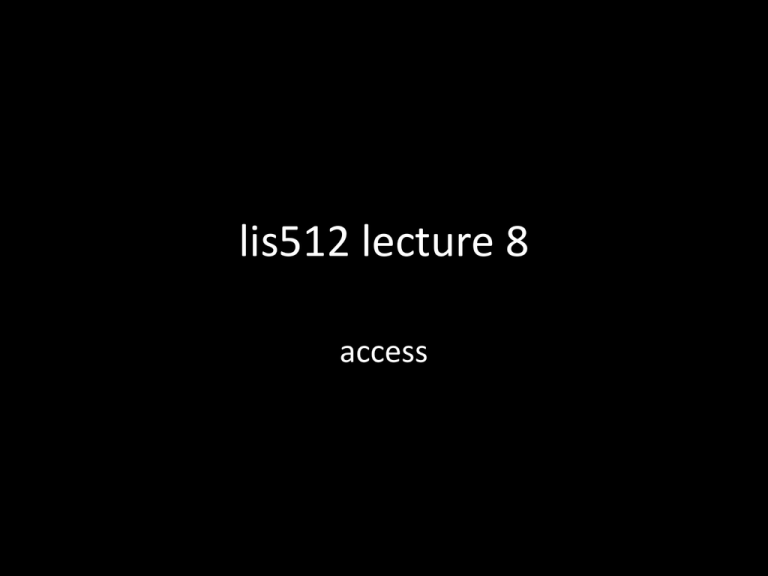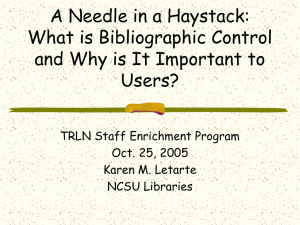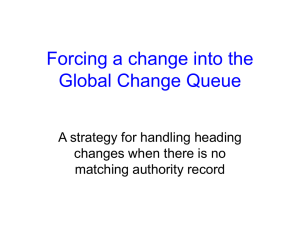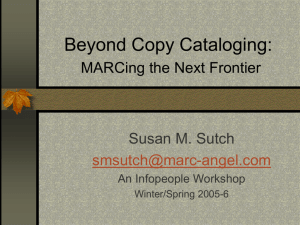Introduction to access points
advertisement

lis512 lecture 8 access description vs access • There are two part to cataloging, called description and access. • The distinction between description and access is peculiar to cataloging. It is not encountered as such in other areas of information organization. • The origin of the distinction, like much of cataloging, goes back to card cataloging. description on a card • In description, you describe the item. • Basically, you create a card catalog for it. The result is a description on a card. • If you just have one card, that’s ok. • But if you have several cards, you need to determine how to have users find the cards they may be interested in. description in a database • If you describe an item in a database table, then, each item is a row in the database. • Each, say, MARC subfield is a column in the database (roughly). • Thus users can search for something that appears in fields using queries to the database. back to the card situation • If you have a large number of cards, each describing an item in the library, you can arrange the cards in a box. • What arrangement will you use? • Typically, you will have to choose one criteria to be the one you list things by. example • You are a car dealership. You want to prepare a list of cars. You could list them by – brand – color – price – time they are sitting in the show room – an attractiveness score made up by a random customer in a library setting • In a library setting the criterion to list all items in a library by is hard to find. • Ideally, we would like to use order all our items, by the criterion that users would like to search for most frequently. • But this criterion is not constant for each item type. This is a serious complication. definitions • We call access point any criterion that allows an alphabetic listing of items. • We call a heading the value that is taken by the access point for an item that we have in our catalog. • An catalog may have several access points. • Accordingly an item may have several headings. • An entry is a MARC term for a heading. main heading • There has been a long-standing debate in cataloging whether – one access point is the main access point. In that case, each cataloging record has a main heading, or – there is a range of access points, each of them is treated equal. In that case all headings have the same status. • We follow MARC records to have a main heading. MARC entries • MARC has the following sections – 1?? – 6?? – 7?? – 8?? “main entry” “subject access” “added entry” “series added entry” • Within these you have – ?00 – ?10 – ?11 – ?30 “personal name” “corporate name” “meeting name” “uniform title” finding the main entry • We use rule 23A to determine the main entry. • This will be put in what is the 1?? fields. • We use rules 23 to 29 to find out what the other entries are that we should set. • These rules say “under the heading of … ” constructing a heading • Concise AACR2 rules tell us how to construct a heading for persons, corporate bodies, geographic names and uniform titles. • We do not apply these rules unless we have to. • Instead we look up headings in the LoC and copy the entries from there, because we are lazy . actually we are not lazy • One of the important functions of headings is to bring various names of the same thing together. • Examples – Bob Dylan vs Robert Allan Zimmerman – Zimbabwe vs Rhodesia • We want to find out what is the best way to name the entity. headers involving names • Names come as corporate names and as personal names. • We first look here at personal names. • Generally, we record works by an author under the heading of the author. • We find the heading under in the LoC. • If we don’t find it we need to build a heading. http://authorities.loc.gov/ • Here we can perform searches, to find authorized headings for names. • Names are used in the ?00 and ?10 field for persons and corporate bodies. • We only use the name as it is written in the Library of Congress record. • Sample search “Thomas Krichel” is easy. • Now search for pope John Paul II. authorized heading personal name • We click trough in the authority to the MARC record for the person and we find values in the 100 field for the authority MARC. • We copy those into our MARC record for the item that we have cataloged. • If we have copy-cataloged, we check the item. We check if the heading that we find for the name is a current heading. • Example: Joseph Ratzinger MARC subfields • Transcribe them as you find them in the LoC record – $a is for the name in it’s authorized form. – $c are titles associated with the name – $b is the numeration – $d are the dates associated with the person – $q is the fuller form of the Examples • • • • $a Hitler, Adolf $d 1889-1945 $a Jesus Christ $a Confuzius $a Carter, Jimmy $d 1924-











